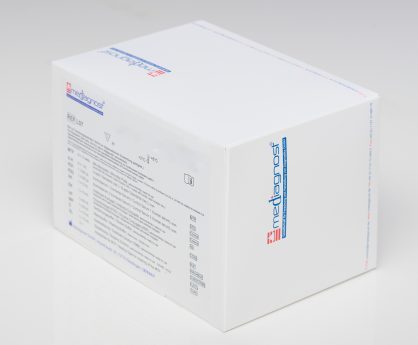Rodent IGFBP-2 ELISA Assay
The Rodent IGFBP-2 ELISA Assay is For Research Use Only
Size: 1×96 wells
Sensitivity: 0.01 ng/ml
Incubation Time: 3 hours
Sample Type: Serum from rat and mouse
Sample Size: 10 µL
Alternative Name: Mouse/Rat IGFBP-2, Insulin Like Growth Factor Binding Protein 2
Product is manufactured by Mediagnost
Assay Principle
The Mouse/Rat IGFBP-2 ELISA, is a so-called sandwich-assay. It utilizes two different specific high affinity polyclonal antibodies for this protein. The IGFBP-2 in the samples binds quantitatively to the immobilized antibody. In the following step, the biotinylated antibody in turn binds IGFBP-2. After washing, a streptavidin-peroxidase-enzyme conjugate will be added, which will bind highly specific to the biotin of the antibody. Subsequently, the peroxidase catalyzes an enzymatic reaction resulting in a blue coloration. The intensity of the blue color depends on the IGFBP-2 content of the sample. The reaction is stopped by the addition of stop solution and color intensity is quantified by measuring the absorption.
Sample stability
- In firmly closable sample vials
- Storage at 4°C:max 3 Days
- Freeze/-thaw cycles: max.5
It is recommended to store samples as soon as possible at least at 4°C. For any long time storage the sample has to be kept frozen at -20°C. Samples were kept frozen and freeze-thaw cycles were applied. Up to 5 freeze-thaw cycles did not change the measured IGFBP-2 concentration significantly.
Hemoglobin in the sample do not interfere to a concentration of 5 mg/mL. However, the use of hemolytic, lipemic or icteric samples should be validated by the user.
Related Products
Rodent IGFBP-3 ELISA Assay
Rodent Leptin ELISA Assay
Mouse/Rat GH ELISA Assay



